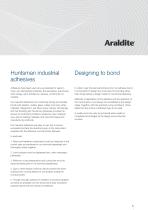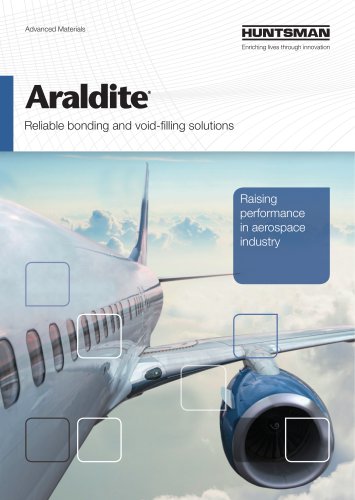
Catalog excerpts

Advanced Materials HUNTSMAN Enriching lives through innovation Adhesives technology
Open the catalog to page 1
A few words about adhesives 4 Huntsman industrial adhesives 5 Advantages of adhesive bonding 6 Adhesive types and main characteristics 10 1-3 Designing a bonded joint 12 Determination of simple lap joints dimensions 20 Durability of a bonded joint 22 Bonding process essentials 24
Open the catalog to page 3
Just about every industrial item produced is composed of components which have to be assembled together. Mechanical fasteners such as screws, rivets or spot welds are frequently used. However, engineers now often choose to use adhesive bonding. This assembly technique is well proven and capable of replacing or supplementing mechanical fastening methods and can provide some advantages which include: > Outstanding lap shear strength and peel strength > Reduced component and/or assembly costs > Improved product performance and durability > Greater design freedom > Less finishing operations A...
Open the catalog to page 4
Huntsman industrial adhesives Adhesives have been used very successfully for years in many very demanding industries, like aerospace, automotive, wind energy, sport and leisure, railways, construction or medical. In order to get the best performance from an adhesive bond, it is important to design the component for bonding rather than simply taking a design made for mechanical fastening. Our industrial adhesives form extremely strong and durable bonds with plastics, metals, glass, rubber and many other materials. Designers in just about every industry increasingly find that bonding with...
Open the catalog to page 5
Advantages of adhesive bonding > Continuous bond The stress is uniformly distributed over the entire bond area when a load is applied whereas the stress is highly concentrated in a few areas when spot welding or mechanical fasteners are used. Bonded assemblies will therefore typically provide a longer service life under load. > Stiffer structures (Figure 1) The continuity of a bonded assembly will produce stiffer structures. Alternatively, if increased stiffness is not needed, the weight of the structure can be decreased while maintaining the required stiffness. > Improved appearance...
Open the catalog to page 6
> Reduced stress concentrations (Figure 2) A bonded structure is inherently a safer structure because the fewer and less severe concentrations of stresses are less likely to induce fatigue cracks. Fatigue cracks will propagate more slowly in a bonded structure than in a riveted structure - or even in a machined profile because the bond lines will typically stop crack formation. > Electrically insulating The adhesive bond can provide an electrically insulating barrier between the surfaces. > Electrically conducting Some adhesives are specifically formulated to offer high electrical...
Open the catalog to page 7
Adhesives technology 1-2 Assessment of bonding Fig.1 Stiffening effect - Bonding and riveting compared Fig.2 Stress distribution in loaded joints The diagram shows how a joint may be designed to take advantage of the stiffening effect of bonding. Adhesives form a continuous bond between the joint surfaces. Rivets and spot welds pin the surfaces together only at specific points. Bonded structures are consequently much stiffer and loading may be increased (by up to 30 - 100%) before buckling occurs. The riveted joint at the top is highly stressed in the vicinity of the rivets. Failure tends...
Open the catalog to page 8
Araldite > Temperature resistance Adhesives are drawn from the class of materials known as ‘polymers', ‘plastics' or ‘synthetic resins' and therefore have their inherent limitations. They are not as strong as metals however the difference is offset by the increased surface contact area provided by the bonded joints. With increasing temperature the bond strength decreases and the strain properties of the adhesive move from elastic to plastic. This transition is usually in the temperature range 70 - 220°C: the transition temperature depends on the particular adhesive. > Chemical resistance...
Open the catalog to page 9
Adhesive types and main characteristics Adhesives are classified either by the way they are used or by their chemical type. High performance adhesives harden via a chemical reaction whereas lower performance types typically harden via a simple physical change. The main types of adhesives typically used in industry today include: > Anaerobics Anaerobic adhesives harden when in contact with metal and air is excluded, e.g. when a screw is tightened in a thread. Often referred to as ‘locking compounds'or ‘thread sealants', they are used to secure, seal and retain machined, threaded, or...
Open the catalog to page 10
> UV curable adhesives Specially modified acrylic and epoxy adhesives, which can be cured very rapidly by exposure to UV radiation. Acrylic UV adhesives cure extremely rapidly on exposure to UV, but require one substrate to be UV transparent. The UV initiated epoxy adhesives can be irradiated before closing the bond line, and cure in a few hours at ambient temperature or may be cured at elevated temperatures. > Epoxies Epoxy adhesives consist of an epoxy resin and a hardener. With many resins and different hardeners to choose from, they allow great versatility in formulation. They also form...
Open the catalog to page 11
Loading conditions It is critical that an assembly which will ultimately be bonded is designed with bonding in mind, rather than simply bonding a design intended for welding or mechanical fastening. When designing bonded joints the following aspects must be considered: > Joint geometry > Adhesive selection > Adhesive performance properties > Service conditions > Stress in the joint > Manufacturing process Bonded assemblies may be subjected to tensile, compressive, shear or peel stresses, or a combination thereof (Figure 3). Adhesives are more resilient under shear, compression and tension...
Open the catalog to page 12
stress component stress component stress component stress component stress component A bonded joint can be loaded in five basic ways (as shown in the diagrams above). Cleavage and peel loading are the most severe as they concentrate the applied force into a single line of high stress. In practice, a bonded structure has to sustain a combination of forces. For optimum strength, the bonded assembly should be designed in such a way as to avoid cleavage and peel stresses.
Open the catalog to page 13

